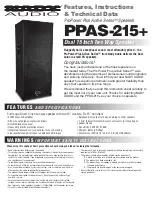
3. In securing your wire, do not
staple or nail through the
insulation. By doing so, a short
could occur in your wire and not
only significantly reduce your
system’s performance but
damage your electronics, i.e.
amplifier, as well.
4. Allow about 2 ½ feet of free wire
at the cut-out to aid in the ease
of installation of your speakers.
This is also helpful if you should
have to remove the speaker
from the wall again for any
reason.
5.
In checking your speakers, make
s u r e p r o p e r p h a s i n g i s
maintained. Simply put, this
means being sure the same wire
which is hooked to the positive
terminal of the amplifier is
hooked to the positive terminal
of the speaker. It is important to
check this on all speakers. If
one speaker is hooked up
incorrectly, or out of phase, the
quality of your bass will be
seriously impaired.
INSTALLATION
As the diagrams show, the
speaker utilizes a metal mounting
ring which, after tightening with the
screws provided, acts as a clamp to
hold the speaker in place.
To aid in speaker performance, a
fibrous material, such as fiberglass
or polyester fiber, may be placed
behind the speaker to help
eliminate unwanted sound from
being transmitted into adjoining
rooms.
Professional installers use quality
equipment. The better the
equipment, the better the installation.
Once you determine where you wish
the speakers to be placed, do the
following:
Using the paper template provided
and the proper equipment, cut the
appropriate sized hole in the wall
making sure that where you wish the
speakers to be placed will not be
obstructed by a stud or other material
hidden in the wall. On drywall, cuts
are best made with a keyhole saw.
If it was done correctly, you should
be able to reach the speaker wire
through the hole. Pull the wire out of
the wall and hook it up to the
terminals on the back of the speaker
assembly, observing polarity (+ & -).
Install the frame and mounting
ring assembly by passing the black
mounting ring through the cut-out as
illustrated above (see figures 1 & 2).
Next, verify that the speaker frame
fits into the cut-out. The white
frame should fit snugly and
smoothly in the cut-out hole.
However, if the hole should have
been cut a little too large, there is
an overlapping frame on the
speaker that will cover this.
Once the frame is in place, begin
alternately tightening the screws
until the mounting ring is up against
the back side of the wall board
being careful not to over tighten
(see fig. 3). Insert speaker into
frame and install the remaining
screws (see fig. 4). Start with the
inner pair of screws followed by the
top pair and then the bottom pair.
Be careful not to over-tighten.
1
2
4
3
OEM Systems Company, Inc.
www.oemsystems.com
WIRING (continued)
Do not over tighten
these screws




















